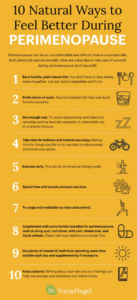Perimenopause affects all women differently. Some women experience mild symptoms, while others feel like their bodies are waging war against them. One day you’re fine, the next you’re sweating through your sheets, snapping at your family, forgetting what you’re doing, and wondering why your jeans don’t fit anymore. If that sounds familiar, you’re not alone – by 2025 over 1 billion women will have experienced perimenopause. And throughout much of history, doctors and culture have dismissed or ignored it altogether.
But here’s the thing – perimenopause isn’t just about the natural process of things, and getting older. It’s not just a hormonal shift happening in isolation. The environment we live in, the food we eat, the air we breathe, and even the technology we use all influence how we experience this transition. Some of the worst perimenopause symptoms – brain fog, fatigue, weight gain, and mood swings – aren’t just about hormones. They’re also about how our bodies process the constant onslaught of toxins, stressors, and inflammatory triggers we’re exposed to every day.
So let’s get into it. What’s really happening in perimenopause, and what can you do to make the transition easier?
What Exactly Is Perimenopause?
Perimenopause is the phase leading up to menopause, typically starting in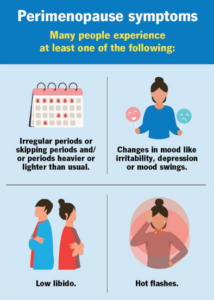 a woman’s 40s (sometimes earlier). While menopause is defined as going a full year without a period, perimenopause is the chaotic transition phase before that – when hormone levels start fluctuating unpredictably. This phase can last anywhere from a few years to over a decade.
a woman’s 40s (sometimes earlier). While menopause is defined as going a full year without a period, perimenopause is the chaotic transition phase before that – when hormone levels start fluctuating unpredictably. This phase can last anywhere from a few years to over a decade.
Common Symptoms:
- Hot flashes and night sweats

- Mood swings, anxiety, or depression
- Irregular or heavy periods
- Brain fog and forgetfulness
- Insomnia or disrupted sleep
- Weight gain, and the inability to lose it
- Skin changes, like dry skin and acne
- Joint pain and muscle aches
- Changes in libido and vaginal dryness
The Environmental Factors That Worsen Perimenopause
Modern life has unfortunately created the perfect storm for hormonal chaos.
We as a society must fully acknowledge that our hormones don’t operate in a vacuum. They’re constantly interacting with environmental chemicals, and unfortunately, many modern products contain endocrine disruptors – substances that mimic or interfere with natural hormone function.
Common Endocrine Disruptors
- BPA & Phthalates (found in plastics, canned food linings, and personal care
 products)
products) - Pesticides & Herbicides (residues on non-organic produce and animal feed, water contamination, direct exposure from lawn and yard care)
- Synthetic Fragrances & Parabens (found in lotions, shampoos, perfumes)
These chemicals can make estrogen levels fluctuate, leading to worsened mood swings, heavier periods, and increased fat storage – especially around the belly.
Air & Water Pollution
Toxins from pollution don’t just affect your lungs – they also disrupt your endocrine system. Heavy metals like lead and mercury, along with industrial chemicals, contribute to oxidative stress, which makes hormonal imbalances worse.
What You Can Do:
- Use a high-quality water filter to reduce exposure to contaminants
- Invest in a really good air purifier – it really is worth it
- Prioritize organic food whenever possible to minimize pesticide exposure
- Rinse fruits and vegetables
- Buy your food from reliable sources, preferably from local businesses and farmer’s markets
EMFs & Chronic Stress Disrupt Hormones
We’re surrounded by electromagnetic fields (EMFs) from Wi-Fi, cell phones, and Bluetooth devices 24/7. While the research is still evolving, mounting evidence suggests that chronic EMF exposure may contribute to stress hormone imbalances, poor sleep, and even potentially exacerbate perimenopause symptoms. Some studies have also indicated that EMFs can interfere with melatonin production, disrupt cellular communication, and increase oxidative stress – all factors that directly impact hormonal balance, inflammation, and overall well-being.
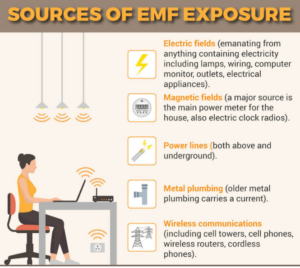
At the same time, modern life keeps us in a near-constant state of stress – always being on the go, the 24-hour news feed, chronic doomscrolling, and the inability to truly relax all keep our cortisol levels raised. Many women in their 40s are already juggling careers, families, and personal health concerns, making them particularly susceptible to chronic stress. This prolonged cortisol elevation (the body’s main stress hormone) can lead to insulin resistance, increased fat storage (especially around the midsection), and worsened estrogen dominance, making perimenopause even more difficult.
Why Aires is The Best (Maybe Only) EMF Protection
While there are plenty of products claiming to “block” or “neutralize” EMFs, Aires is the only solution we’ve seen that is actually backed by rigorous scientific testing. Instead of attempting to block EMFs (which is nearly impossible or just simply redundant in our tech-driven world), Aires devices work by diffracting electromagnetic fields, helping to reduce the biological stress response caused by constant exposure.
Scientific studies on Aires’ devices have demonstrated its effectiveness in:
- Reducing oxidative stress and EMF-related inflammation
- Supporting cellular communication and nervous system function
- Mitigating the physiological impact of EMFs on the body
For those navigating perimenopause, reducing environmental stressors – including EMF exposure – can make a tangible difference in symptoms like poor sleep, brain fog, and fatigue.
What You Can Do:
- Limit screen time before bed to support melatonin production. Use blue light-blocking glasses if using screens at night.
- Use an EMF-protection device like Aires to mitigate exposure and support cellular health.
- Prioritize stress management techniques such as meditation, breathwork, yoga, exercise, and time in nature to regulate cortisol levels.
- Turn off Wi-Fi at night and keep your phone on airplane mode when sleeping to minimize unnecessary EMF exposure during rest.

Processed Foods & Seed Oils Fuel Inflammation
The standard modern diet is loaded with oxidized seed oils (like soybean and canola oil), artificial additives, and refined sugars – all of which contribute to chronic inflammation. Since inflammation is directly tied to hormonal health, eating a diet high in ultra-processed foods can worsen everything from mood swings to hot flashes, and weight gain.
What You Can Do:
- Focus on whole, nutrient-dense foods as close as possible to what you’d find in nature.
- Swap seed oils for healthier fats like olive oil, coconut oil, and grass-fed butter or ghee.
- Reduce sugar intake to support blood sugar stability and hormone balance.
How Lifestyle & Environmental Changes Can Help
While you can’t stop perimenopause from happening, you can control many of the external factors that influence perimenopause symptoms. Here are some of the biggest changes that can make a difference:
Detox Your Daily Routine
- Swap out plastic food storage for glass or stainless steel.
- Choose non-toxic skincare and household cleaning products.
- Reduce synthetic fragrance exposure
- Wear natural fiber clothing, like cotton or wool (ditch the polyester)
- Choose natural period care, use organic pads and tampons
Support Your Hormones
- Eat more phytoestrogen-rich foods like flaxseeds and fermented soy (which
 help balance estrogen levels naturally).
help balance estrogen levels naturally). - Cut back on caffeine and alcohol, which can worsen hot flashes and sleep disturbances.
- Support adrenal health with adaptogens like ashwagandha or rhodiola.
- Consider BHRT (bioidentical hormone replacement therapy)
- Make sure you are getting enough Vitamin D and sunlight (most women are D deficient)
Reduce EMF Exposure
- Turn off Wi-Fi at night.
- Keep your phone and other devices on airplane mode when sleeping, (or don’t sleep with them nearby)
- Use EMF-reducing technology from Aires to mitigate potential effects.
Prioritize Sleep and Stress Reduction
- Avoid screens at least an hour before bed to support melatonin production.

- Try magnesium supplementation or herbal teas to improve sleep quality.
- Incorporate breathwork, yoga, or grounding techniques to reduce stress.
Focus on Gut and Liver Health
- Eat probiotic-rich foods (kimchi, sauerkraut, yogurt) to support gut health.
- Eat whole grains, plenty of protein and healthy fats
- Drink plenty of filtered water to help flush toxins.
- Incorporate cruciferous vegetables (broccoli, cabbage, cauliflower) to support estrogen metabolism.
When to Seek Help & What to Ask Your Doctor
If perimenopause symptoms are severely affecting your quality of life, it’s worth talking to a healthcare professional.
Some Questions to Ask
- Should I get my hormones tested? (Blood, saliva, or urine tests can reveal imbalances.)
- Is hormone therapy right for me? (Bioidentical hormones can be a safer alternative to synthetic options.)
- Are there natural treatments that could help? (Some doctors, especially functional docs are open to discussing adaptogens, acupuncture, and other holistic therapies.)
Remember: every woman’s perimenopause experience is unique. What works for someone else may not work for you, so it’s okay to experiment with different approaches.
Final Thoughts
Perimenopause can feel overwhelming, but you can do things to make it more bearable. By reducing exposure to environmental toxins, supporting your body with the right foods and habits, and advocating for your health, you can take control of this life transition.
You don’t have to just “deal with it.” You can make changes that support your body and make this phase of life easier. Start where you can, experiment, and listen to what your body is telling you. While perimenopause might be inevitable, suffering through it doesn’t have to be. And remember to be patient with yourself and this journey (you’re going to be there for a while).


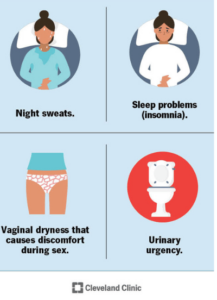
 products)
products)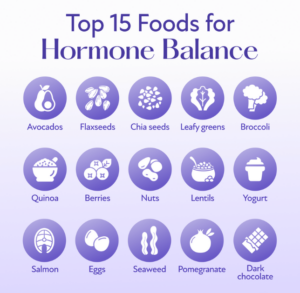 help balance estrogen levels naturally).
help balance estrogen levels naturally).